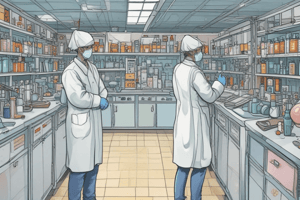Podcast
Questions and Answers
What is a method of sterilization that uses pressurized gases?
What is a method of sterilization that uses pressurized gases?
- Ionizing radiation
- Incineration
- Moist heat
- Filtration (correct)
What is a component of a laboratory safety program?
What is a component of a laboratory safety program?
- Fire safety
- Electrical safety
- Chemical safety
- All of the above (correct)
What is a risk associated with working in a microbiology laboratory?
What is a risk associated with working in a microbiology laboratory?
- Fire hazards
- Electrical shocks
- Chemical spills
- Laboratory acquired infections (correct)
What should be checked regularly in a laboratory?
What should be checked regularly in a laboratory?
What document should a laboratory have in place for chemical safety?
What document should a laboratory have in place for chemical safety?
What is the purpose of disinfecting all instruments immediately after use in a microbiology laboratory?
What is the purpose of disinfecting all instruments immediately after use in a microbiology laboratory?
What is a critical factor in the success of sterilization, disinfection, or decontamination in a health care setting?
What is a critical factor in the success of sterilization, disinfection, or decontamination in a health care setting?
What is the term for the removal of pathogenic microorganisms so items are safe to handle or dispose of?
What is the term for the removal of pathogenic microorganisms so items are safe to handle or dispose of?
Why is it necessary to wash hands after working with infectious materials in a microbiology laboratory?
Why is it necessary to wash hands after working with infectious materials in a microbiology laboratory?
What is a key aspect of safety programs in microbiology laboratories?
What is a key aspect of safety programs in microbiology laboratories?
Flashcards
Sterilization
Sterilization
Kills all forms of microbial life, including bacterial endospores.
Disinfection
Disinfection
Destroys pathogenic organisms, but not necessarily all microorganisms, endospores, or prions.
Decontamination
Decontamination
Removal of pathogenic microorganisms to make items safe to handle or dispose of.
Factors Affecting Sterilization/Disinfection
Factors Affecting Sterilization/Disinfection
Signup and view all the flashcards
Physical Methods of Sterilization
Physical Methods of Sterilization
Signup and view all the flashcards
Chemical Methods of Sterilization
Chemical Methods of Sterilization
Signup and view all the flashcards
Chemical Hygiene Plan
Chemical Hygiene Plan
Signup and view all the flashcards
Fire Evacuation Plan
Fire Evacuation Plan
Signup and view all the flashcards
Electrical Safety Measures
Electrical Safety Measures
Signup and view all the flashcards
Study Notes
Laboratory Safety
- Microbiology laboratories require adherence to safety guidelines to prevent accidents and exposures to infectious agents.
Safety Precautions
- Wear gloves when handling infectious materials
- Wash hands after working with infectious materials
- Disinfect all instruments immediately after use
- Use water to moisten specimen labels rather than the tongue
- Disinfect contaminated waste before discarding
- Report accidents or exposures to infectious agents to appropriate personnel
Safety Programs
- Expanded to include:
- Proper handling of biologic hazards in patient specimens and infectious microorganisms
- Fire and electrical safety
- Safe handling, storage, and disposal of chemicals and radioactive substances
- Techniques for safely lifting or moving heavy objects
Sterilization, Disinfection, and Decontamination
- Sterilization: kills all forms of microbial life, including bacterial endospores
- Disinfection: destroys pathogenic organisms, but not necessarily all microorganisms, endospores, or prions
- Decontamination: removal of pathogenic microorganisms to make items safe to handle or dispose of
Factors Affecting Sterilization, Disinfection, and Decontamination
- Organic load (organisms and other contaminating materials)
- Type of organisms present
- Concentration and exposure time to the germicide
- Physical and chemical nature of the surface
- Temperature, pH, humidity, and presence of a biofilm
Methods of Sterilization
- Physical methods:
- Incineration
- Moist heat
- Dry heat
- Filtration
- Ionizing (gamma) radiation
- Chemical methods:
- Ethylene oxide gas
- Hydrogen peroxide gas plasma
- Vaporized hydrogen peroxide
- Other liquid chemicals
Chemical Safety
- Chemical hygiene plan required
- Guidelines for proper labeling of chemical containers
- Manufacturers material safety data sheets (MSDSs)
- Written chemical safety training and retraining programs
Fire Safety
- Post fire evacuation plans in each laboratory
- Strategies for finding the nearest exit in case of fire
Electrical Safety
- Check electrical cables regularly for fraying and replace when necessary
- Use only three-prong, grounded plugs
- Check sockets for electrical grounding and leakage at least annually
- No extension cables should be used in the laboratory
Handling of Compressed Gases
- Compressed gas cylinders (CO2, anaerobic gas mixture) contain pressurized gases and must be properly handled and secured
Biosafety
- Laboratory-acquired infections can occur through various exposures in microbiology laboratories
- Risks may extend to adjacent laboratories and families of laboratory workers
Studying That Suits You
Use AI to generate personalized quizzes and flashcards to suit your learning preferences.




